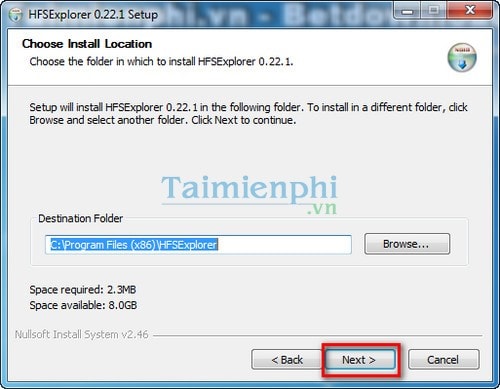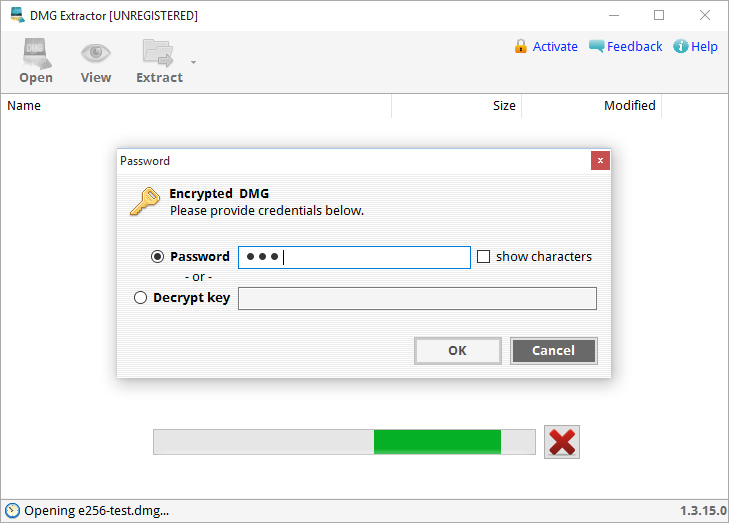DMG is a disk image format used on Mac OS X and it is difficult to open on Windows computer. So, the guide below will let you people give a way to open DMG files on Windows through a free utility name HFSExplorer. Continue reading after the break to read the complete process to do that.
How to Extract DMG File Data on Windows
How to open Apple's DMG files in Windows 10. By Roger Fingas Friday, June 07, 2019, 08:45 am PT (11:45 am ET) One of the potentially frustrating things about switching back and forth between Mac. It automatically extracts the contents of the files to your computer; Opens encrypted or non-encrypted DMG files; Extract 4GB+ DMG files. Open macOS DMG files on Windows. Extract any file from a DMG archive in just a few clicks. 30 day money back guarantee Expert support for 1 year.
Step-1
The DMG file type is primarily associated with 'Macintosh OS X' by Apple Inc. On the Macintosh, these files are treated like a real disk. They can be created with Disk Copy, burnt to CD or mounted as a normal volume. If you have a.DMG file on a Windows PC it's likely you have a Macintosh file and you won't be able to use what is in it.
Download and install HFSExplorer on your PC
Step-2
Just follow the installation wizard of HFSExplorer and check mark the box followed by “Register .dmg file association” while you reach on this screen
Step-3
On completion of HFSExplorer install process, you will observe that all DMG files on your computer will get associated to HFSExplorer software.
Step-4
Now, double click on your DMG file to whom you want to open

Step-5
In an explorer window all of the contents of your DMG file will display, so select the file of your choice and click on “Extract” button
Step-6
Just choose the destination folder on your computer and click on “Extract here” button
Step-7
Click on “Yes” button while it asks for “Do you want to follow symbolic links while extracting”
Step-8
Extraction will start and on completion “Extraction finished” message will display, so click on “OK” and that’s it
Related Content
Summary
Encrypting files with EFS (Encrypting File System), Bitlocker, or other encryption methods can greatly improves the data security. But how to decrypt encrypted files without a password, or certificate? Follow the encrypted file recovery tips here to troubleshoot. For ransomware encrypted file recovery, you can use EaseUS Data Recovery Wizard to help you recover the deleted original files with ease.
Questions About How to Decrypt Files
Q1: 'I recently encrypted some of my files in Windows 10 and kept my encryption key in my Documents folder in C drive. I reinstalled Windows OS the other day, and the encryption key was lost due to formatting. Can I decrypt the file without the certificate?'
Q2: 'Unknown viruses encrypted all files and folders on my USB pen drive. I was threatened to pay Bitcoin to recover encrypted files, which I don't want to. I need a way to decrypt encrypted files without a password.'
Overview of Encrypted File Recovery
Sometimes we tend to protect privacy by using some file encryption tools, such as EFS (Encrypting File System), which provides the core file encryption technology used to store encrypted files on NTFS file system volumes. So only with a certificate can people access the EFS locked files.
How to Encrypt a File in Windows 10/8/7
1. Find the file or folder you wish to encrypt.
2. Right-click the file/folder and click 'Properties.' Then, click the 'Advanced...' button on the General screen.
3. Check the box 'Encrypt Contents to Secure Data' under the Compress or Encrypt attributes section, then click the 'OK' button.
4. Continuing clicking the 'OK' button. An encryption warning box will pop up.
5. Check the 'Encrypt the File Only' box to encrypt the individual file, then click 'OK' to finish.
Note: If you copy unencrypted files to a folder with encrypted property, they will be automatically encrypted.
EFS encryption is transparent. If you encrypt some data, you can access this data without any restriction. And you can decrypt the files system by unchecking the 'Encrypt Contents to Secure Data' feature. Yes, this only works for the file system, not your specific file. If you want to decrypt files, the certificate or password is indispensable.
How to Decrypt Encrypted Files Without Password/Key
If you haven't exported and backed up the file encryption certificate before or if you have forgotten the password, you cannot decrypt encrypted files in the following situations.
How Do I Open Encrypted Dmg Files In Windows 7
- Reinstalling Windows OS
- Moving encrypted files to another computer
- Recovering data from an encrypted disk
Suppose that you really need to decrypt files, you can search and try some online decryption tools. But you need to be aware that these tools are not 100% safe. You may be at risk of data theft or source data corruption. So think twice before trying these programs.
In addition to this case, where users actively use tools to encrypt, there is another unexpected way of files being encrypted, which is by viruses or ransomware. For example, ransomware encrypts and deletes files. In the next part, we will show you how to use a reliable ransomware encrypted file recovery tool to get back data without paying the ransom.
How to Recover Files Encrypted by Ransomware
Since most ransomware encrypts your files and folders by three steps: make an exact copy of files and folders > encrypt the copy > delete the source files. How this works gives you a great opportunity to recover the encrypted files through professional data recovery software.
Here, we highly recommend you try EaseUS Data Recovery Wizard. This virus attack data recovery program enables you to recover files infected by shortcut virus, restore files deleted and encrypted by ransomware like Locky, CryptoLocker, CryptoWall, and TorrentLocker, without paying.
Now, download this capable data recovery tool and start to recover ransomware encrypted files within three steps. Note that this is just for file recovery of shortcut virus or ransomware, not including those by encryption tools.
Step 1. Launch EaseUS Data Recovery Wizard. Select the disk partition or storage device where you lost files and click the 'Scan' button.

Step 2. This program will quickly start a scanning process to find lost files. When the process accomplishes, you can double-click files to have a preview before selection.
Step 3. Choose the files you want. Then click the 'Recover' button to get them back. You should save the data to another safe spot in your PC/storage device, not where they lost.
- 1. Unformat the drive
- 2. Repair the RAID, RAW disk or operating system
- 3. Recover lost partition (the one that cannot be recovered by software)
Sum Up
You can use EFS or Bitlocker to encrypt your files and data. But to avoid losing the password, key, or certificate and not being able to decrypt files, we suggest you back up your encryption certificates and keys to a safe location, and remember your EFS backup password.
How To Open Dmg Files Windows 10

For solving the encryption problem caused by ransomware, the most important thing is preventing virus infection. Install and enable the anti-virus software on your computer. Moreover, back up important data and files on your computer regularly.